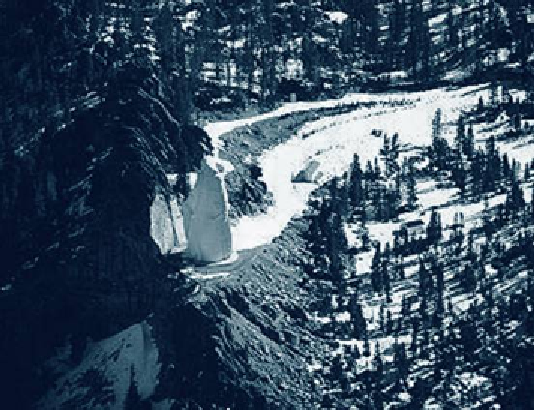Environmental Engineering Reference
In-Depth Information
is the name for iron and aluminium compounds that stain streambeds. Copper causes a
bright blue-green stain. Sometimes oxidized rock is stained black.
One of the most serious aspects of ARD is its persistence in the environment (
Case 13.7
).
An acid-generating mine waste storage facility has the potential for long-term, severe
impacts on surface and groundwater and aquatic life. The process will continue until there
are no remaining sulphides. This can take centuries, given the large quantities of exposed
rock at some mine sites. Once the process of acid generation has started, it is difi cult to
stop. The combination of acidity and dissolved metals may harm or even kill aquatic life,
rendering streams nearly sterile and making water uni t for human consumption.
Predicting the potential for acid drainage can help determine where problems may
occur. Methods vary from simple calculations involving the balance of acid-generating
minerals (e.g. pyrite) against the existence of neutralizing minerals (e.g. calcium carbonate)
to complex laboratory tests (e.g. kinetic testing). However, even laboratory-based tests may
not always accurately predict the amount of metals that will be leached if acid drainage
occurs, because of the differences in scale and composition that occur when samples are
analyzed off-site (Da Rosa 1997).
CASE 13.7
The Berkeley Pit in Butte, Montana
'Our Lady of The Rockies', a 30 m statue of steel, overlooks
the mining town of Butte. It is an old European tradi-
tion to place an image of the Holy Lady at the portal of
underground mines to ask for heavenly protection for the
men working underground.
As such the erection of the huge statue appears appropri-
ate. For more than a century, miners, mining, and the mining
industry have brought wealth and sophistication to Montana
as a whole, and the town of Butte in particular. The Mining
Law of 1872 still allows speculators to remove minerals from
public lands for just a small fee. If not for mining, Montana
would not have been settled for years after it actually was.
But in those days, people did not understand the long-term
impacts mining practices could have on the land.
In 1955, Butte's fi rst large-scale open-pit mine, the
Berkeley Pit, was constructed on 'the hill.' Mining ceased in
1982 after the extraction of 1.5 billion tons of ore. The
Berkeley Pit reached a fi nal depth of about 600 m.
During operation, groundwater was continually pumped
from the mine so that miners could reach the ore. In 1982
the water pumps at the bottom of the pit were shut down.
Acid groundwater with a pH less than 3 continues to fi ll
the pit which has now become the Berkeley Pit Lake. The
water is also toxic because large quantities of heavy metals
have been dissolved in the pit lake water.
The Pit received national attention as an example of
environmental damage when a fl ock of migrating snow
geese chose to land and rest on the Berkeley Pit Lake in
November of 1995. They drank the highly acidic water and
close to 350 died.
Unless a way is found to safely and economically
treat and remove the pit water, scientists believe that
it will spill out into the Silver Bow drainage system
between the years 2010 and 2020. In the meantime,
Berkeley Pit Lake remains the Environmental Protection
Agency's largest Superfund site in the US. That means that
the US Government has deemed the Berkeley Pit
the number one environmental hazard facing the
USA today.
Back in 1994, after a court ruling which pressured cer-
tain mines to become a little more environmentally sensitive,
the director of the Montana Environmental Information Center
stated, 'The decision means you fi ll up a hole when you get
through mining. There will be no more Berkeley Pits.'









Search WWH ::

Custom Search